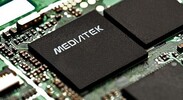Mediatek MT6735 vs Mediatek Helio P23 MT6763V vs Mediatek Helio A20 MT6761D
Mediatek MT6735
► remove from comparison
The 1.5 GHz MediaTek MT6735 is a 64-bit ARM-based SoC launched in 2014 primarily for small budget to mainstream Android devices. The quad-core processor is manufactured in 28 nm and is based on the Cortex-A53 architecture. It integrates a cat.4 LTE modem with CDMA2000 and an ARM Mali-720 GPU capable of decoding and encoding videos of up to 1080p30. Compared to the MT6732, the MT6735 utilizes a slower graphics unit.
Processor
The Cortex-A53 is the successor to the popular Cortex-A7 design. In addition to the jump from 32-bit to 64-bit architecture (ARMv8 ISA) to address more than 4 GB of memory, the new design offers better branch prediction and higher performance-to-power ratio that rivals the Cortex-A9. The four cores of the MT6732 are clocked at up to 1.5 GHz and sits roughly in between the Qualcomm Snapdragon 610 (4x Cortex-A53 at 1.7 GHz) and Snapdragon 410 (4x Cortex-A53 at 1.2 to 1.4 GHz). The power-efficient processor is fit for common tasks like browsing and running light applications.
Graphics
The integrated single-core Mali-T720 is an entry-level GPU clocked at up to 600 MHz (450 MHz likely). Most Android games will play at acceptable frame rates on medium resolutions and quality.
Features
The MT6732 SoC integrates a memory controller (32-bit LPDDR3, 6.4 GB/s), multiple radios (WLAN, Bluetooth, GPS), and a cellular modem (GSM, UMTS, GPRS, HSPA+, HSUPA, TD-SCDMA, EVDO, and LTE Cat 4). Its integrated video engine allows for 1080p playback at 30 FPS. Cameras are supported up to 13 MP.
Mediatek Helio P23 MT6763V
► remove from comparison
The Mediatek Helio P23 MT6763V is a mainstream ARM SoC for smartphones (mainly Android based) that was introduced in 2017. It is manufactured in a 16 nm FinFET+ process and is equipped with 8 ARM Cortex-A53 CPU cores. The cores are divided in two clusters, a performance cluster clocked at up to 2 GHz (versus 2.3 GHz in the official specs for the similar P23 MT6763T) and a power efficiency cluster clocked at up to 1.65 GHz (unverified). The chip also includes an LTE modem (Cat. 7 DL / Cat. 13 UL with Dual-SIM support) and a 802.11a/b/g/n WiFi modem. The integrated ARM Mali-G71 MP2 GPU is clocked at up to 770 MHz and has two cluster (from 32). The integrated memory controller supports DDR4x (Dual-Channel?) at 1500 MHz and LPDDR3 (Single Channel only) at 933 MHz. The video engine supports H.264 de- and encoding but only decoding (playback) of H.265/HEVC.
Mediatek Helio A20 MT6761D
► remove from comparison
The Mediatek Helio A20 MT6761D is an entry-level ARM SoC for smartphones and tablets (mainly Android-based) that was introduced in 2020. It integrates four ARM Cortex-A53 cores clocked at up to 1.8 GHz. It integrates a PowerVR GE6300 GPU clocked at up to 550 MHz. The integrated memory controller supports LPDDR4x (max. 4 GB at 1200 MHz). Furthermore, a LTE radio with Cat-4 DL (150 Mbps download) and Cat-6 UL (50 Mbps upload) and a 802.11 a/b/g/n/ac Wi-Fi 5 modem is integrated.
Compared to the similar named A22 MT6761, the MT6761D offers lower clocked CPU and GPU cores and a slower LTE modem, but is produced in the modern 12 versus 16nm process.
| Model | Mediatek MT6735 | Mediatek Helio P23 MT6763V | Mediatek Helio A20 MT6761D | ||||||||||||||||||||||||||||||||||||||||||||||||||||||||||||||||||||||||||||||||||||||||||||||||||||||||||||||||||||||||||||||||||||||||||||||||||||||||||||||||
| Codename | Cortex-A53 | Cortex-A53 | Cortex-A53 | ||||||||||||||||||||||||||||||||||||||||||||||||||||||||||||||||||||||||||||||||||||||||||||||||||||||||||||||||||||||||||||||||||||||||||||||||||||||||||||||||
| Series | Mediatek | Mediatek Helio 20 | Mediatek Helio 20 | ||||||||||||||||||||||||||||||||||||||||||||||||||||||||||||||||||||||||||||||||||||||||||||||||||||||||||||||||||||||||||||||||||||||||||||||||||||||||||||||||
| Series: Mediatek Helio 20 Cortex-A53 |
|
|
| ||||||||||||||||||||||||||||||||||||||||||||||||||||||||||||||||||||||||||||||||||||||||||||||||||||||||||||||||||||||||||||||||||||||||||||||||||||||||||||||||
| Clock | 1500 MHz | 2000 MHz | 1800 MHz | ||||||||||||||||||||||||||||||||||||||||||||||||||||||||||||||||||||||||||||||||||||||||||||||||||||||||||||||||||||||||||||||||||||||||||||||||||||||||||||||||
| Cores / Threads | 4 / 4 | 8 / 8 | 4 / 4 | ||||||||||||||||||||||||||||||||||||||||||||||||||||||||||||||||||||||||||||||||||||||||||||||||||||||||||||||||||||||||||||||||||||||||||||||||||||||||||||||||
| Technology | 28 nm | 16 nm | 12 nm | ||||||||||||||||||||||||||||||||||||||||||||||||||||||||||||||||||||||||||||||||||||||||||||||||||||||||||||||||||||||||||||||||||||||||||||||||||||||||||||||||
| Features | Rel. 9, Cat. 4 LTE (FDD & TDD), DC-HSPA+, TD-SCDMA, CDMA2000 1x/EVDO Rev. A, EDGE, 802.11n Wi-Fi, Bluetooth 4.0, 13MP image signal-processor, | Mali-G71 MP2, Dual-Channel LPDDR4X-322 / LPDDR3-1866 | PowerVR GE8300, Dual-Channel LPDDR4X 1200 MHz (4GB max.), eMMC 5.1, Wi-Fi 5, BT 5.0 | ||||||||||||||||||||||||||||||||||||||||||||||||||||||||||||||||||||||||||||||||||||||||||||||||||||||||||||||||||||||||||||||||||||||||||||||||||||||||||||||||
| iGPU | ARM Mali-T720 ( - 600 MHz) | ARM Mali-G71 MP2 (770 MHz) | PowerVR GE8300 ( - 550 MHz) | ||||||||||||||||||||||||||||||||||||||||||||||||||||||||||||||||||||||||||||||||||||||||||||||||||||||||||||||||||||||||||||||||||||||||||||||||||||||||||||||||
| Architecture | ARM | ARM | ARM | ||||||||||||||||||||||||||||||||||||||||||||||||||||||||||||||||||||||||||||||||||||||||||||||||||||||||||||||||||||||||||||||||||||||||||||||||||||||||||||||||
| Announced | |||||||||||||||||||||||||||||||||||||||||||||||||||||||||||||||||||||||||||||||||||||||||||||||||||||||||||||||||||||||||||||||||||||||||||||||||||||||||||||||||||
| Manufacturer | www.mediatek.com | www.mediatek.com | www.mediatek.com |
Benchmarks
Average Benchmarks Mediatek MT6735 → 100% n=8
Average Benchmarks Mediatek Helio P23 MT6763V → 189% n=8
Average Benchmarks Mediatek Helio A20 MT6761D → 159% n=8
* Smaller numbers mean a higher performance
1 This benchmark is not used for the average calculation













